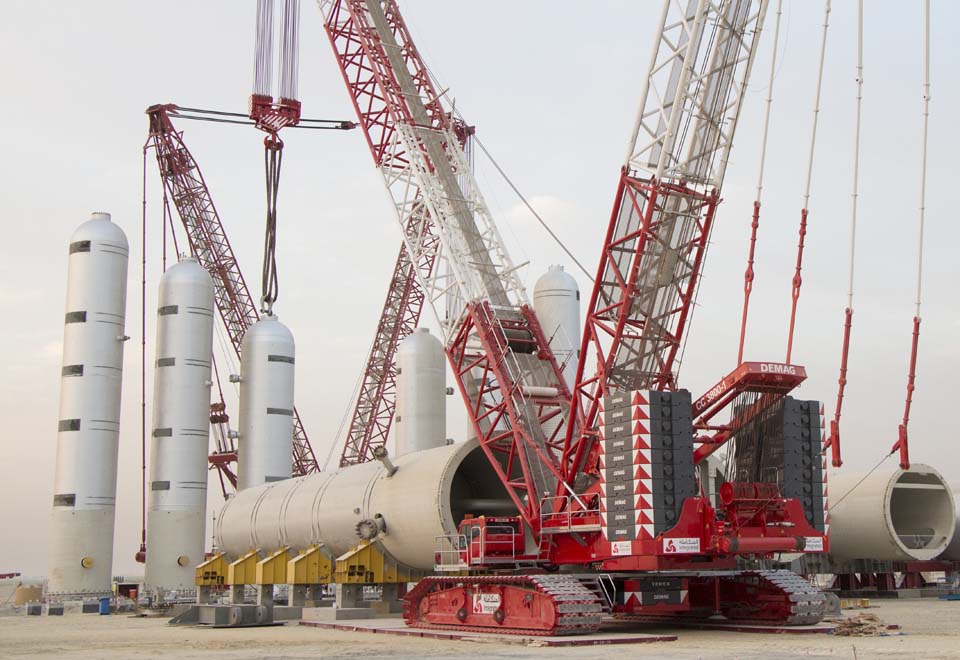Terex Cranes has sold just two crawler units in the Middle East so far this year: a Demag CC 2400-1 and a CC 2800-1, but Joerg Mueller, senior manager for international sales at Terex Cranes, is confident that things will improve – especially in Saudi Arabia.
He notes: “The [Middle East] market is not as big as it was before, but we still have some enquiries, and we will have to see how it goes.
“In Saudi Arabia, our expectations are improving compared with 2016, when everyone was pulling out or de-investing, but [either way] not buying new stuff – so the situation is getting better.
“Saudi Arabia was our biggest market before, and last year was terrible: we didn’t sell a single unit. But I expect that it will get better by the end of 2017, and definitely by 2018.”
This situation contrasts sharply with previous years, when – in Saudi Arabia alone – Terex Cranes might sell up to 40 crawler, all-terrain and rough-terrain cranes a year.
Looking to the future with its product, Terex Cranes introduced a Boom Booster kit for its Demag CC 3800-1 lattice boom crane in June that can increases the maximum system length to 183m and its capacity by up to 30%.
As Mueller notes: “It’s a 650-tonne crane already, but if you want to lift something that’s a bit on top of this, you can use the Boom Booster, which basically strengthens all of the statics. It will not extend the total capacity, but it will extend the load moment for certain lifts – which in certain applications makes sense.”
Contrasting Terex’s super boom system with the similar extension recently launched by Liebherr for its LR1750 he adds: “Ours in more compact: Liebherr’s is over three metres in width – so it will be difficult and more expensive to transport it in the [Middle East[ region.”
In Europe, these booms extensions are especially directed towards the wind segment, where the growing size and weight of wind turbines is rapidly driving up the cost of transport and assembly.
However, the same segment represents a rising concern in the Middle East, where many regional governments have ambitious plans to roll out renewable energy, and have already set aside significant budgets for wind energy development.
Indeed, it was a Liebherr LR1750 was recently used by the Dammam-based Gulf Haulage Heavy Lift Company to erect the first commercial wind turbine in Saudi Arabia.
Questioned on the potential growth of the wind segment in the region, Mueller adds: “That would be great. In Jordan there have been a couple of projects. In Germany, it is a big thing, and most of our crawler cranes in the CC 3800-1 range go for wind turbine erection.
“If that kicks off then definitely it would be a big driver for the market. It’s an ideal crane for that market, because in Germany you already have wind turbines that are over 170m.”
One of the few potential challengers to crawler cranes in the wind segment could come from Mammoet, which is currently developing two dedicated cranes for wind turbine assembly and maintenance.
Mueller responds: “The way wind turbines are erected – with crawler cranes – is proven in Germany. We are already at around 170 units with the CC 3800-1, and that only started selling three years ago – so those are quite big numbers.
“One of the benefits of this crane is that it is so versatile – there are so many different ways of changing the jib and other parts of the crane to suit different heights and applications.”
That versatility is needed in the region, where, he adds: “A lot of customers do different jobs. The big companies that might do wind turbines – such as Sarens Nass or GHHL – also work in the oil and gas industry and construction.”



